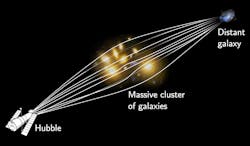Hubble detects most distant single star yet, 28 billion lightyears away
The light of a massive and superbright star that existed within the first billion years after the Big Bang and creation of the universe was detected by an international team of researchers via data from the Hubble Space Telescope and a fortuitous lineup of a massive cluster of galaxies that formed a gravitational lens between Earth and the star.
In Einstein’s general relativity, “massive objects bend the space around them,” says Brian Welch, a PhD candidate in astronomy and astrophysics at Johns Hopkins University, who discovered the star and nicknamed it “Earendel,” the Old English word for “morning star.”
When light from distant sources travels through this warped space, it appears as if the light is bending around the massive object. “Just like light being redirected through a glass lens, gravitational lensing changes how we see background sources,” he explains. “In particular, we see gravitationally lensed objects as magnified and distorted images, which can be stretched into long arcs.” They call this one the Sunrise Arc.
When small objects like stars align perfectly with the foreground lens, they can reach extremely high magnifications, such as this case where the star is magnified by several thousand times.
“The line running through the source galaxy where this maximum magnification alignment happens is called the caustic,” Welch says. “A good visualization for it is ripples on a swimming pool. The ripples focus the sunlight into bright points on the floor of the pool. Similarly, the gravitational lens creates points where, if a star aligns with this ‘ripple,’ its light appears brighter to our telescopes.”
A gravitational lens provides such extreme magnification. “No current or planned telescope would be able to make these kinds of observations without the assistance of these ‘cosmic telescopes.’ The fact we can use structures in the universe to improve our studies of the distant universe is incredible to me,” he says.
Hubble’s two instruments involved in this discovery are cameras, rather than spectrographs. One of them, wide-field camera 3 (WFC3), has a wide wavelength coverage—it’s sensitive to light with wavelengths from 200 nm (UV light) to 1700 nm (NIR light). The second is the advanced camera for surveys (ACS), and its wavelength range extends from the ultraviolet, through the visible, and out to the near-infrared.
“As with all astronomical cameras, the detectors are black or white,” says Peter Laursen, an astrophysicist and academic research member of the Niels Bohr Institute, the Cosmic Dawn Center in Denmark. “They only detect ‘light’ or ‘no light.’ To see what an object looks like in various wavelength regions, we use filters that can be either broadband or narrowband, but there are also mediumband ones. Narrowband filters typically let light through in a region that’s on the order of 100 Å, while broadbands have widths on the order of 1000 Å.”
The most amazing part of this work for Victoria Bellinger Strait, a postdoc at the Cosmic Dawn Center, is that “we can see what is possibly a single star so far away.”
And for Strait the realization she’s looking at light 28 billion lightyears away is “the really inspiring part of working in astronomy—thinking about large scales really puts me, humanity, the Earth, the solar system into perspective,” she says. “It makes me feel small, but in an inspiring way. It’s wonderful to feel such a sense of place within the universe.”
Until now, sources observed at redshift~6 where this star is, “entire galaxies looked like fuzzy, unresolved blobs,” Strait adds. Astronomers use redshift to measure distance and describe what’s happening as the universe expands and light from distant objects gets stretched or shifted to longer, redder wavelengths as it travels toward us.
“We’ve never seen just a single star at this distance until now, and this is the surprising and exciting part,” Strait says. “The result also is pretty robust for something at such a huge distance. And the various magnification models that predict a very magnified source where Earendel is located all make very different assumptions about dark matter mass distributions—but all predict Earendel is also highly magnified.”
The team views their work as an exciting initial discovery and hopes the real science will come with the Webb space telescope.
“We’ll be able to tell whether Earendel is one star or maybe a binary star system, what type(s) of star it is, and other information about its chemical composition,” Strait says. “We expect stars and galaxies at this distance to have different chemical makeups than the galaxies we see locally, so it will be an interesting test to see how different this one is.”
The early universe was also a much different place than the universe today. “Discovering this star gives us a new window into this early epoch, and allows us to study how stars in these early days form and evolve,” says Welch. “Future observations with Webb will further improve our understanding of Earendel, improving our estimate of its mass and measuring its temperature and composition. Hopefully Webb will also break this record and find more lensed stars at earlier times—potentially revealing the very first stars to form in the universe.”

Sally Cole Johnson | Editor in Chief
Sally Cole Johnson, Laser Focus World’s editor in chief, is a science and technology journalist who specializes in physics and semiconductors. She wrote for the American Institute of Physics for more than 15 years, complexity for the Santa Fe Institute, and theoretical physics and neuroscience for the Kavli Foundation.
